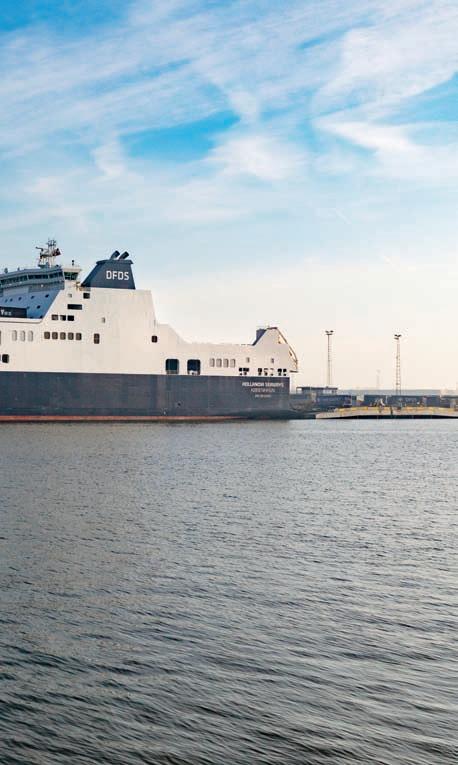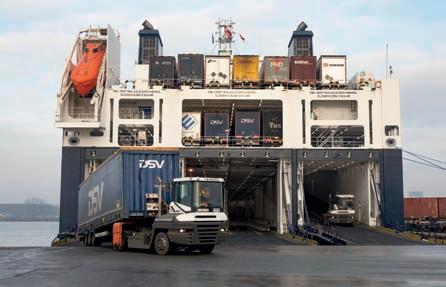
17 minute read
Revitalising 4.4 hectares


hexaport adds value and labour to north sea port
All images courtesy of Hexagon
one of north sea port’s goals is to use the port area as effi ciently and effectively as possible. one solution is to revitalise existing vacant sites, which strengthens the port economy without utilising new terrains.
Property developer Hexagon recently announced the acquisition of an unused 4.4ha terrain. The terrain includes 29,000m 2 of commercial space in total. After decommissioning, renovating, and construction, a total volume of 27,000m 2 for offi ces, storage and production remain for sale. Jelle Vandendriessche, Managing Director of Hexagon, explains the company’s plans to PortNews.
Hexaport

Mercatorlock

locAted At north seA port, Just Alongside the ghent-terneuZen cAnAl, hexAport is A perfect operAting bAse.
“At Hexagon we specialise in the acquisition of existing, vacant commercial sites with the aim of redeveloping them. The Hexaport project will be realised on what used to be one of the Belgian sites of JM Balmatt. This company started producing asbestos in Ghent in the Seventies, but went bankrupt in 1998. After this, the location was, among others, used by a recycling company. The investment company from which we bought the site ultimately owned the premises. They rented out the warehouse facilities on an irregular basis to various companies for logistics and storage purposes.”
No soil sanitation The part of the facility that was in use as asbestos factory is going to be decommissioned, as it contains a lot of asbestos. “Of course, the demolition of the factory needs to be carried out with great care, and according to legal rules and regulations”,

Jelle vAndendriessche, mAnAging director of hexAgon: “hexAport is strAtegicAlly locAted towArds both the western scheldt river And the dense network of multimodAl routes to the hinterlAnd.” After decommissioning, renovAting, And construction, A totAl volume of 27,000m 2 for offices, storAge And production remAin for sAle.
LangerbruggestraatLangerbruggestraat
LangerbruggestraatLangerbruggestraat
BB C1.K C1.3 C1.K C1.3 C1.2 C1.3C1.2 C1.3 C2C2
A1 A2 A3A1 A2 A3 A4A4
Mr Vandendriessche explains. “But other than this, it was good to learn that there is no need for soil sanitation, so together with the decommissioning we could also start with the renovation of the warehouses that will remain in use.” He continuous, “The buildings that we are currently taking care of have a surface of around 5,800m 2 and 7,800m 2 . They have a free clearance height of 12m. Each building has a number of loading ramps, and approximately 300m 2 of office space.”
Four times 2,500 Hexaport also plans the construction of an additional 10,000m 2 of warehouses with an equal 12m clearance height, loading ramps, and office space. For the construction, Hexagon applied for a building permit for four 2,500m 2 units. “This way,” Mr Vandendriessche explains, “there is no obligation to construct the 10,000m 2 all at once. With this flexibility, companies can also buy a smaller warehouse and it gives us the opportunity to build in parts, rather than the total volume. Our goal is to first sell and then start constructing. Though when desired, we can build the entire 10,000m 2 in one go, adding the four units together into one spacious production and/or storage facility.”
Perfect operating base Located at North Sea Port, just alongside the Ghent-Terneuzen canal, Hexaport is a perfect operating base. “Hexaport is strategically located towards both the Western Scheldt River and the dense network of multimodal routes to the hinterland,” states Mr Vandendriessche. “As these kind of locations are scarce, the activities of companies that want to settle down here obviously have a certain amount of port dependency.” Despite this obligation, Mr Vandendriessche experiences plenty of interest from the market. “Hexaport offers ample opportunities for both industrial and logistic purposes. So far, we are engaging in some serious talks with potential customers.”
logistic and industrial opportunities of the port area. It is also a fine example of a so-called ‘infill development’, in which existing and vacant sites are given a new purpose. Having sustainability high on its strategic agenda, the Port Authority is also happy with the decommissioning of the buildings containing asbestos. Finally, with the future logistic and industrial activities, the project will furthermore contribute to additional regional labour and added value. “When we got in touch with the Port Authority for the first time to talk about our plans, we met a lot of willingness to cooperate and this really helped us to get the project started”, comments Mr Vandendriessche. “And their commercial department is very helpful, for example by introducing prospects to us.”
Better living environment Just like North Sea Port, the municipality of Ghent sees the project as a positive development of the region, with the city of Ghent slowly expanding up north towards the port area. “The municipality is glad to see that we are revitalising the terrain”, voices Mr Vandendriessche. “Apart from the employment and added value, it will contribute to a better living and working environment as well”, he concludes. According to him, the sales value of the total site lies around EUR 20 million. Renovation has already started, along with sales activities. The construction of the newly built part will begin this summer. If everything goes according to plan, the first new customers should be able to start their business at Hexaport by mid-2021.
WOrkInG WItH A LOnGEr tErM PLAnnInG WInDOW GIvES AMPLE COMfOrt AnD CALMnESS In tHE EntIrE LOGIStICS CHAIn.

Just-in-time logistics
Sustainable and cost-effective
Last year, the Dutch Green Deal Zeevaart, Binnenvaart en Havens (Sea Shipping, Inland Shipping and Ports) became effective, which is an agreement between forty parties, among which the Dutch Ministry of Infrastructure and Water Management, the Dutch Ministry of Economic Affairs and Climate, trade organisations, knowledge institutes, and seaports represented by their trade organisation BOZ. With this agreement, all parties committed themselves to a number of joint agreements to make shipping more sustainable between 2020 and 2050.
fOr DfDS, nOrtH SEA POrt’S trIAL WItH A nEW LOCk PLAnnInG HAS BEEn vEry SuCCESSfuL.
Facilitating role for seaports According to Thomas Desnijder, Policy Advisor Energy at North Sea Port, the Green Deal aims at reducing the exhaust of nitrogen dioxides, sulphur dioxides, and particulate matters, as well as the emission of greenhouse gases (CO 2 ). “Goals,” he says, “are confirmed in the Green Deal to reduce CO 2 emissions by 2050 for seagoing vessels with at least 70% when compared to 2008. For inland shipping, the goal is to have emission-free vessels that are climate-neutral by 2050. Action plans have been drawn up to reach these objectives, and the roles for executing the plans and realising the goals have been described. The actions first of all imply technical measures for the vessels, but the Green Deal also looks at other solutions in which ports can play a role.”

of actions are described in the Green Deal, which can be summarised as follows:
For inland shipping – Look for more uniformity in the way of stimulating sustainable inland shipping by means of tariffs and/or discounts, and meanwhile effectively meet the goals of the Green Deal. – Stimulate logistic chain optimisation. – Realise a model with uniform fundamentals for inland shipping to remove barriers for inland shipping in the logistics process. – Facilitate the expansion of shore power and based on
demand, the location for the change of batteries, as well as the infrastructure for alternative, sustainable fuels.
Alain de Brauwer, Route Operations Manager at DFDS “For DFDS, North Sea Port’s trial with a new lock planning has been very successful. The new schedule based on a planning of four months ahead has resulted in a higher reliability of our trips to and from Ghent. Because of this, we could also schedule our largest vessel Hollandia Seaways. Although we must always face circumstances beyond our control such as bad weather conditions, we have been able to raise efficiency, also towards all our customers (mainly Volvo Ghent), to lower costs, and to reduce our CO 2 footprint. So are in favour of continuing this way of scheduling our liner services.”



– Optimise the Environmental Ship Index and Green Award, in order to make the discount on port tariffs for greener vessels better suited to the Green Deal objectives. – Look for further chain optimisation by means of the development of digital tools and by improving the collaboration in the logistics chain. – BOZ, together with KNVR (the Dutch association of ship owners) and terminal operators, are going to discuss the possibility of implementing the just-in-time principle in all seaports, and to investigate the option of joining an international programme that endorses an equal just-in-time principle.”
Improved planning Frederik Dierckens, Head of Nautical department at North Sea Port, offers his view on the efforts from North Sea Port in the field of just-in-time logistics. “The Green Deal suggests a number of goals and actions to reduce the harmful exhaust of inland and seagoing vessels. Although we do not have direct influence on the techniques used for vessels, we can play a facilitation role, for instance by providing shore power facilities. In fact, even without the Green Deal many ports are already putting great effort into sustainability, though the agreement surely helps to coordinate things better. One of the projects we have been working on recently is improving the planning of seagoing vessels that arrive at the entrance of the GhentTerneuzen Canal on their way to our port. This project aims at the reduction of delays and a better traffic flow to and from the part of our port, located behind the Terneuzen lock system.” The locks near Terneuzen connecting the Ghent-Terneuzen Canal with the Western Scheldt act as a physical bottleneck. The planning for North Sea Port so far is ruled by the planning of the locks. Vessels with destination Terneuzen or Ghent aspire to arrive at the locks with as little delay as possible. “The running order of vessels arriving at the locks is organised on a ‘’first come, first serve’ base. This principle is improved for regular liner services and vessels using nautical services, like pilots and tugboats, by granting them a certain level of priority. For the ‘first come, first serve’ system, the time of arrival at the pilotage station on the North Sea is leading. Simply said, the estimated time of arrival at the pilot station determines the order of planning, a planning that is final six hours prior to entering the locks.”
Wilco de Zwart, Sector Manager Logistics, Outokumpu “For our regular liner services, good planning is very important, as it will affect our entire supply chain. The test with the new schedule has so far turned out highly satisfactory for us, also because it did not negatively affect the arrival and departure of non-liner vessels. We expect that the new routine will help to adequately respond to future delays caused by extensive construction works on the New Lock at Terneuzen and the decommissioning of the Middle Lock, as this will add additional stress on the West Lock.”
At times when it is very busy at the locks, vessels will have to wait much longer before entering the locks. According to Mr Dierckens, this leads to undesirable, but foreseeable delays. “What we see is that vessels on their way to the Western Scheldt show an uncoordinated, ineffective way of travelling. The planning for entering the port is only final a couple of hours prior to arriving at the pilot station, leading to very little time for our nautical service providers to respond. This also means that ships don’t have the opportunity to react to foreseeable delays and adapt their speed accordingly. Everyone understands that this is not an ideal situation. It leads to inefficient sailing, with higher fuel consumption, costs, and pollution as result. By the time the vessels arrive, they usually have to wait longer than desired. These delays cost a lot of time, money, and fuel, thus impacting the environment as well. As part of a supply chain system, one waiting vessel leads to a chain reaction at terminals, at production facilities, and for nautical service providers, which are all affected by the delay. And this will ultimately also alter the vessel’s return trip, which might cause even more delay. Hence the focus on liner services for our test, as turnaround time and sailing schedule are not only key for sailing, they are paramount to their entire business model.”
PORt CASe

tHE StuDEntS Of HOGESCHOOL GEnt AnD HZ unIvErSIty Of APPLIED SCIEnCES ExCHAnGED tHEIr fInDInGS DurInG A HALf-tErM MEEtInG In DECEMBEr.
Another just-in-time logistics project initiated by North Sea Port is a cross-border project in which students of Hogeschool Gent (Ghent) and HZ University of Applied Sciences (Vlissingen) collaborate. “Together with POM Oost-Vlaanderen (the development company of the province of Oost-Vlaanderen), North Sea Port supports companies in optimising their logistics chain”, comments Mr Stefan Yzewyn, Advisor Logistic and Infrastructure at North Sea Port. “This support entails the sharing of information, initiating activities, and developing projects. By doing so, we want to raise economic growth, efficiency, and sustainability.” With this in mind, the Port Authority initiated this Port Case regarding just-in-time logistics. Mr Yzewyn explains, “With just-in-time logistics, we mean that goods arrive or leave at the desired time. For this, it is important that the entire chain, from origin to destination, are geared towards each other and delays are avoided.” The student survey’s overall aim was to propose logistic operational improvements in the alignment between parties in maritime and inland shipping. The case involved three questions: identify the bottlenecks, know how to deal with the
bottlenecks, and formulate an optimisation of the logistics flow. Mr Yzewyn continues, “The main purpose of the study was to investigate and recommend, and meanwhile it could act as relevant input for the Green Deal programme. Students should of course take into account the desires of the various companies. For logistics companies, wishes depend on the type of commodity handled, their connections with the hinterland, and position within the port.”
To keep the students aligned, the case was given a certain focus by North Sea Port and POM Oost-Vlaanderen: – Focus should lie on bottlenecks that cause late arrivals or departures of goods, for example due to lack of staff and quay capacity, but also on logistic operational flows that could be optimised. – Solutions can be proposed within the trajectory, from the pilot station located in the North Sea until the moment the goods arrive at their loading/unloading berth. – For inland shipping, (potential) logistical barriers on all Belgian and Dutch inland waterways are relevant. – Optimisations for maritime shipping should not negatively influence inland shipping. – It is assumed for the case that the adjustments of the lock system at Terneuzen, such as the new lock, are ready. – Focus lies on existing process, operational solutions, and improvements, or ones that can be swiftly implemented. – Solutions should fit within the Green Deal agreements.
The survey is well underway and the students of both institutes exchanged their findings during a half-term meeting in December. In March, the results will be presented and assessed in a meeting with the collaborating companies. Maritime service providers will be informed about the results in April, so as to find out where their challenges lie. “Depending on the final results, it will be decided if the survey will have a follow-up programme,” says Mr Yzewyn, “but no matter what the findings will be, the Port Case is a fine example that demonstrates the benefits of cross border cooperation from universities in the region, as supported by North Sea Port.”
Improve planning horizon Based on the experience of the nautical department and customers, North Sea Port started a project a few months ago to solve this problem. This project of improving the planning towards the locks, was instigated for various reasons, which are described below.
– First of all, the construction of the new Terneuzen lock
may lead to extra delays, as the Middle Lock is no longer available for seagoing vessels. The Middle Lock will be entirely decommissioned in 2022, putting even more stress on the West Lock in the search of additional capacity to lock capacity for inland barges. – Vessels are getting increasingly larger, which makes usage of the full capacity of the locks more difficult. – A better planning of the vessels will help to improve the
terminal operator’s planning for the deployment of people needed to unload and/or load the vessels, the planning for further transport of goods to the hinterland, the planning for maritime service providers, and will prevent delays at production facilities in the port area. – A better planning will improve the predictability and reliability of operations. – A better planning will improve sustainability.
“In summary,” Mr Dierckens explains “it was the intention to improve the planning horizon of the port user (just-intime logistics), to make the nautical chain more reliable, and to make the start-up routes of the shipping services more economical and sustainable.” The test started in September and lasted until December 2019. After this period, the project results were examined, concluded, and discussed with all parties concerned. Mr Dierckens continues, “For the test, we collaborated with DFDS, I-Motion Shipping, Wagenborg, and Outokumpu. These companies all have liner services on a frequent and regular base. We asked them to provide us with their sailing schedule of four months ahead. In the test phase, the scheduled services were locked through according to these sailing schedules, instead of the regular schedule based on calculated arrival times and assigned prioritisation. A decreasing margin was used so that the reliability of the proposed lockage increased as the remaining sailing time decreased, while still leaving flexibility to optimise the locking sequence. The planning for these vessels became definite 24 hours before arrival, instead of the usual 6 hours. We expected that all this would result in an improved lock operation flow. In case a liner vessel would arrive outside its sailing schedule, the existing prioritisation of the lock planning was applied. During the test, the other sea and inland vessels remained scheduled via existing methods and agreements.”
An impressive 90% success rate After the trail period, North Sea Port now concludes that the results are positive. “During the test,” explains Mr Dierckens, “sixteen vessels participated, with a total amount of 174 inbound passages through the lock and 135 outbound.
HAnDLInG Of GOODS At tHE tErMInAL Of OutOkuMPu. A BEttEr PLAnnInG Of tHE vESSELS WILL fOr ExAMPLE HELP tO IMPrOvE tHE tErMInAL OPErAtOr’S PLAnnInG fOr tHE DEPLOyMEnt Of PEOPLE nEEDED tO unLOAD AnD/Or LOAD tHE vESSELS.

We have learnt that an impressive amount of 90% of the passages was executed according to the planning at least 24 hours in advance. This was around 50% in the months preceding the test. Apart from these plain figures, the parties involved also are very satisfied. Not only was reliability improved, the test furthermore did not negatively affect the passages of the other vessels at the locks. Working with a longer term planning window gave ample comfort and calmness in the entire logistics chain. Based on a prudent calculation, an estimated EUR 1.5 - 2 million is annually saved in fuel consumption, resulting in a subsequent reduction in CO 2 emissions of approximately 20 - 30,000t.” With these positive results in mind, North Sea Port has decided to start implementing the new planning procedure into daily practice step-by-step. Earlier planning based on a reliable sailing schedule should in time become standard for vessels with destination North Sea Port. Mr Dierckens concludes, “With the test, we have shown that where there is a will, there is a way. Together with all parties, we have proven that more adequate planning is possible. We think that this is not only helpful for vessels that need to enter the Ghent-Terneuzen Canal, but for all other destinations in our port as well. Even more, all ports are more or less dealing with the same issues. Other ports that want to learn from our experience have already contacted us for information. Ports, and the complete logistics chain in between, act as communicating vessels. Our planning project will hopefully finally result in an optimal just-in-time logistics operation on an international multi-port level, contributing to higher efficiency, lower costs, and more sustainable shipping.”










